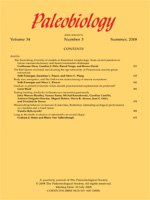Intrinsic features of organisms, such as morphology or DNA sequences, and the stratigraphic occurrence of fossils provide distinct evidence of the phylogenetic history of life. Because there is only one true history, we expect the historical signals preserved by these data sets to be similar, and several metrics have been developed to measure the fit of phylogenetic hypotheses to the fossil record. However, a variety of biases affect these metrics, and it is unclear whether they can provide more than an estimate of whether one tree fits the fossil record better than another when used on their own. Here we explore two novel applications of stratigraphic fit metrics when they are used with a combination of phylogeny reconstruction methods that do and do not directly include stratigraphic occurrence data (e.g., cladistics and stratocladistics). In particular, we are interested in whether differences in the stratigraphic fit of cladistic and stratocladistic trees can be used to identify cases in which the stratocladistic results are likely to be more accurate, as well as whether such differences can be used to identify potential problems in the underlying data sets.
Using 550 simulated data sets that were analyzed with cladistics and stratocladistics, we found that the absolute difference in fit to stratigraphy between the results of the two methods was strongly correlated with the probability of character state transition and the accuracy of the stratocladistic results relative to the cladistic results. Completeness of the fossil record and number of taxa included in the analysis were more weakly correlated with stratigraphic fit, and the statistical significance of the differences in fit between the two sets of results did not show a meaningful relationship with improvements in accuracy or potential data problems. These results suggest that measuring the difference in stratigraphic fit between cladistic and stratocladistic trees might be useful for qualitatively estimating whether the addition of stratigraphic data benefited a phylogenetic analysis, and for identifying data sets with high average rates of character state change.





